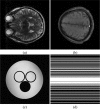Balanced sparse model for tight frames in compressed sensing magnetic resonance imaging
- PMID: 25849209
- PMCID: PMC4388626
- DOI: 10.1371/journal.pone.0119584
Balanced sparse model for tight frames in compressed sensing magnetic resonance imaging
Abstract
Compressed sensing has shown to be promising to accelerate magnetic resonance imaging. In this new technology, magnetic resonance images are usually reconstructed by enforcing its sparsity in sparse image reconstruction models, including both synthesis and analysis models. The synthesis model assumes that an image is a sparse combination of atom signals while the analysis model assumes that an image is sparse after the application of an analysis operator. Balanced model is a new sparse model that bridges analysis and synthesis models by introducing a penalty term on the distance of frame coefficients to the range of the analysis operator. In this paper, we study the performance of the balanced model in tight frame based compressed sensing magnetic resonance imaging and propose a new efficient numerical algorithm to solve the optimization problem. By tuning the balancing parameter, the new model achieves solutions of three models. It is found that the balanced model has a comparable performance with the analysis model. Besides, both of them achieve better results than the synthesis model no matter what value the balancing parameter is. Experiment shows that our proposed numerical algorithm constrained split augmented Lagrangian shrinkage algorithm for balanced model (C-SALSA-B) converges faster than previously proposed algorithms accelerated proximal algorithm (APG) and alternating directional method of multipliers for balanced model (ADMM-B).
Conflict of interest statement
Figures













Similar articles
-
Local sparsity enhanced compressed sensing magnetic resonance imaging in uniform discrete curvelet domain.BMC Med Imaging. 2015 Aug 8;15:28. doi: 10.1186/s12880-015-0065-0. BMC Med Imaging. 2015. PMID: 26253135 Free PMC article.
-
Undersampled MRI reconstruction with patch-based directional wavelets.Magn Reson Imaging. 2012 Sep;30(7):964-77. doi: 10.1016/j.mri.2012.02.019. Epub 2012 Apr 13. Magn Reson Imaging. 2012. PMID: 22504040
-
Compressed sensing MRI via fast linearized preconditioned alternating direction method of multipliers.Biomed Eng Online. 2017 Apr 27;16(1):53. doi: 10.1186/s12938-017-0343-x. Biomed Eng Online. 2017. PMID: 28449672 Free PMC article.
-
An Algorithm Combining Analysis-based Blind Compressed Sensing and Nonlocal Low-rank Constraints for MRI Reconstruction.Curr Med Imaging Rev. 2019;15(3):281-291. doi: 10.2174/1573405614666180130151333. Curr Med Imaging Rev. 2019. PMID: 31989879 Review.
-
Compressed sensing for body MRI.J Magn Reson Imaging. 2017 Apr;45(4):966-987. doi: 10.1002/jmri.25547. Epub 2016 Dec 16. J Magn Reson Imaging. 2017. PMID: 27981664 Free PMC article. Review.
Cited by
-
Blind Primed Supervised (BLIPS) Learning for MR Image Reconstruction.IEEE Trans Med Imaging. 2021 Nov;40(11):3113-3124. doi: 10.1109/TMI.2021.3093770. Epub 2021 Oct 27. IEEE Trans Med Imaging. 2021. PMID: 34191725 Free PMC article.
-
Self-supervised sparse coding scheme for image classification based on low rank representation.PLoS One. 2018 Jun 20;13(6):e0199141. doi: 10.1371/journal.pone.0199141. eCollection 2018. PLoS One. 2018. PMID: 29924830 Free PMC article.
-
Frame-Based CT Image Reconstruction via the Balanced Approach.J Healthc Eng. 2017;2017:1417270. doi: 10.1155/2017/1417270. Epub 2017 Sep 17. J Healthc Eng. 2017. PMID: 29201330 Free PMC article.
-
[Compressed sensing magnetic resonance image reconstruction based on double sparse model].Sheng Wu Yi Xue Gong Cheng Xue Za Zhi. 2018 Oct 25;35(5):688-696. doi: 10.7507/1001-5515.201607006. Sheng Wu Yi Xue Gong Cheng Xue Za Zhi. 2018. PMID: 30370706 Free PMC article. Chinese.
-
Efficient Sum of Outer Products Dictionary Learning (SOUP-DIL) and Its Application to Inverse Problems.IEEE Trans Comput Imaging. 2017 Dec;3(4):694-709. doi: 10.1109/TCI.2017.2697206. Epub 2017 Apr 21. IEEE Trans Comput Imaging. 2017. PMID: 29376111 Free PMC article.
References
-
- Haacke, EM, Brown, RW, Thompson, MR, Venkatesan, R. Magnetic Resonance Imaging: Physical Principles and Sequence Design. John Wiley and Sons; 1999.
-
- Lustig M, Donoho DL, Santos JM, Pauly JM. Compressed sensing MRI. IEEE Signal Processing Magazine. 2008;25(2):72–82. 10.1109/MSP.2007.914728 - DOI
Publication types
MeSH terms
LinkOut - more resources
Full Text Sources
Other Literature Sources
Medical

